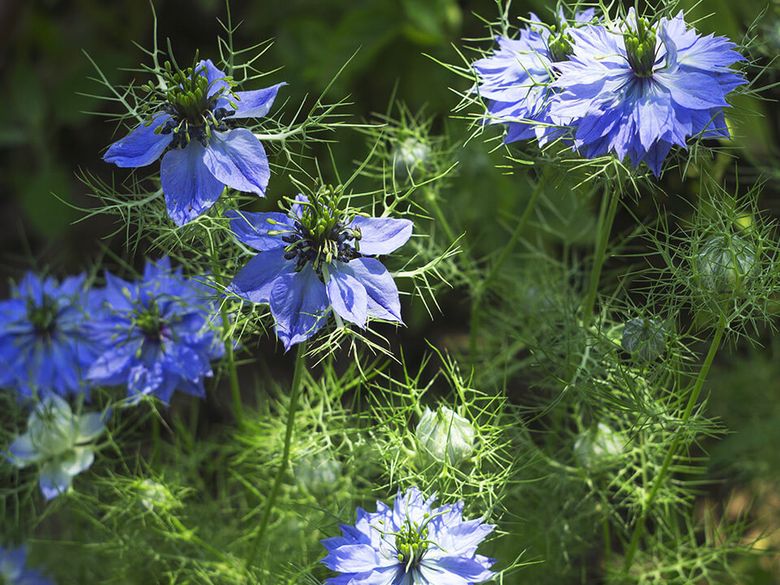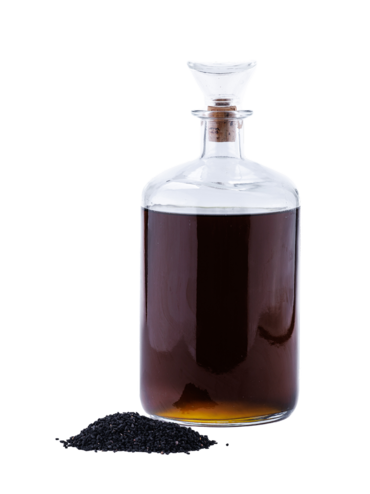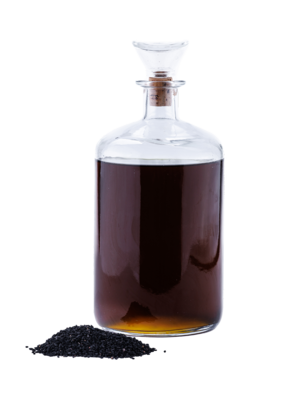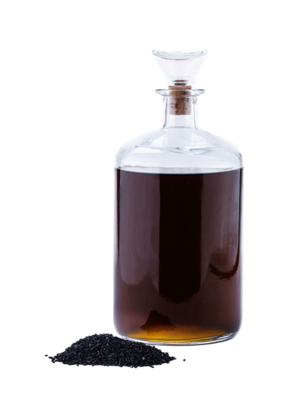Our Black cumin seed oil qualities
We carry Black cumin seed oil in the following qualities for you
Usage
|
Cosmetics |
Food |
Pharmaceutics |
|
|---|---|---|---|
| Black cumin seed oil cold pressed | |||
| Black cumin seed oil cold pressed Egyptian seed | |||
| Organic black cumin seed oil cold pressed | |||
| Organic black cumin seed oil cold pressed Egyptian seed |

Genuine black cumin
Black cumin seed oil is obtained from the seeds of the genuine black cumin. Black cumin (lat. Nigella) belongs to the buttercup family and is native to the Mediterranean region with about 20 species. The up to 25 - 60 cm high, annual herbaceous plant is slightly hairy and has strikingly pinnate leaves with a leaf width of up to 2 mm. The white, blue or purple, end-set flowers are greenish or bluish in colour at the tips.
After flowering from June to August, Nigella sativa forms poppy-like capsules up to 2 cm long, containing over 100 seeds. The seeds are about 2 mm in size, oblong, angular, slightly curved, black and have a pleasant nutmeg-like odour. When the seeds are harvested, the stalks are first mown down and then placed in bundles on cloths to dry. Whilst drying, the bundles are turned regularly. The seeds are then threshed from the capsule and dried again. The seeds contain about 20 - 40 % fat. In terms of taste, black cumin is slightly similar to sesame with a slight cumin note.
Black cumin is related neither to caraway nor to cumin. A relative is the ornamental plant "Love-in-a-Mist" (Nigella damascena) which can be found in our gardens.
The seeds are preferably sown in sunny growing areas in spring and harvested in summer.
Would you like to be informed about the general market situation of Black cumin seed oil and our other products?
subscribe to market reportCultivation & yield
The main harvest time of black cumin is in September, when the plants start dying from below.
The plant is native to North Africa, especially Egypt, where it is cultivated. Other growing areas are India, Turkey, Iraq, North Africa and the Middle East.

Background / history
For more than 2,000 years, black cumin has been used in the Orient as a peppery spice and medicine.
The historical roots of black cumin seed go back to statements by Mohammeds (570-632 A.D.), who is said to have said about 1,500 years ago "Black cumin heals every disease except death. But long before this statement, people believed in the special effect of black cumin. In the grave of Pharaoh Tut-ench-amun a bottle of black cumin seed oil was found as an offering for life after death. In the tenth century, the Islamic physician Ibn Sina also described the healing effect of black cumin seed in his book "The Book of Recovery of the Soul". This book was the standard work at European universities for over half a millennium. In Egyptian folk medicine, black cumin is still recommended today as an antiflatulent and diuretic tea and its pressed oil for the treatment of the upper airways. In Indian Ayurvedic medicine, its alleged milk-increasing effect on breastfeeding mothers is particularly noted.
A subspecies of black cumin, Nigella Sativa, originates from North Africa, Southern Europe and the Near East, where its seeds were used early on as a spice and in medicine.
The genuine black cumin (Nigella sativa) was given the popular name "Katharinenblume" because of its wheel-shaped flowers. This flower is reminiscent of the torture wheel of Saint Catherine. Other common names are Kookäem, Kookämer, Black Caraway, Black Cumin.
Even today the black seeds, which are also called black onion seeds in Asia, are scattered like sesame on pita bread. In German trade it is often available under the Panjabi-name Kalonji. Black cumin seed is a component of the Bengali spice mixture Panch Phoron.
900
kg
IBC
190
kg
Drum
27
kg
Canister
General durability: canister 12 months, drum 18 months, IBC 6 months
Nutritional values & composition
| Nutritional value | (per 100g) |
| Energy | 3,700 kJ / 900 kcal |
| Fat | 100 g |
| Saturated fatty acids | 16 g |
| Monounsaturated fatty acids | 25 g |
| Polyunsaturated fatty acids | 59 g |
Fatty acids ratio
Composition
| C16:0 Palmitic acid | 8 – 14 % |
| C18:1 Oleic acid | 18 – 30 % |
| C18:2 Linoleic acid | 50 – 65 % |
You want to buy Black cumin seed oil?
Request now free of charge and without obligation from Gustav Heess. We deliver Black cumin seed oil ...
- worldwide
- fast
- reliable
We offer Black cumin seed oil in the following packaging units:
-
900
kg
IBC -
190
kg
Drum -
27
kg
Canister

